How To Fix Old Windows That Won't Stay Up
Even high-quality wood windows tin can rot or develop problems over time. Hither are proficient means to fix them.
Repairs with home windows boil down into two bones groups: 1) fixing problems with window frames and sash, and 2) replacing or repairing window drinking glass. In this commodity, we look at window frame and sash problems. For information on window glass repairs, please see How to Supplant or Repair Window Glass.
Just to be clear, window sash is the office of a window that holds the glass. Windows may have either fixed or operable sash, as discussed in the article Window Buying Guide. Both types can have problems only, of course, operable windows may have additional problems with their mechanisms. Operable windows commonly work reliably for years, merely, with time, their workings tin get balky.
Windows fabricated from metal or composites take fewer problems created by weather than wood windows, considering forest is prone to rot with prolonged exposure to dampness and can crevice with exposure to dominicus. Wood is too delectable to termites.
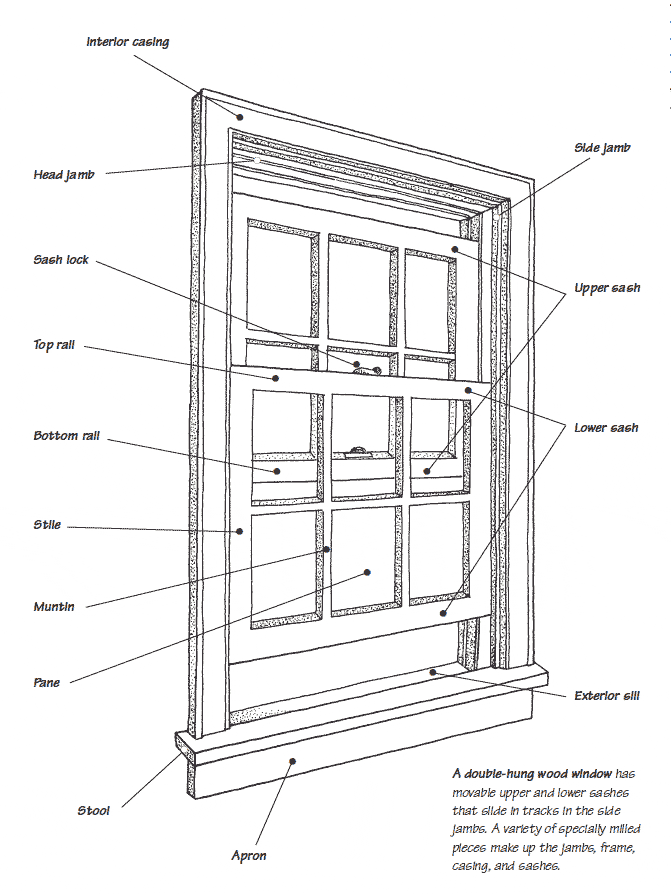
Double-hung woods windows—the blazon with a lesser section you tin raise and a elevation department you lot can lower—are the biggest offenders. When they become bad, they're well-nigh impossible to open.
Repainting wooden frames every iii to five years, depending on your prevailing weather conditions, will preserve them—just don't let built-up paint seal them shut. When painting them don't let paint lap over whatever moving parts. Too, yearly maintenance, such as filling cracks with putty and caulking the edges, will go a long way toward protecting them.
Even vinyl and aluminum windows need a footling basic care to go on them working smoothly. You tin can scrub both types with a natural bristle brush and detergent solution. If y'all have anodized aluminum frames, you can restore their luster by polishing them with fine steel wool and so coating them with paste wax.
Repairing Rotted Woodwork
Where a woods sill or sash has taken serious corruption from conditions, resulting in rot, yous can use epoxy wood filler, bachelor at home centers, to repair the expanse. (If large areas are affected, talk with a carpenter about cutting-out and replacing sections of the wood or the unabridged sash.) Contact a window replacement or repair contractor if you need help.
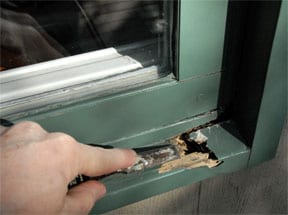
ane Use a chisel to dislodge almost of the loose, rotted wood. Drill a few ane/4-inch holes into the damaged woods. Soak the entire rotted area with liquid epoxy "consolidant" to transform the area into a sturdy base of operations for filler. Let the woods absorb it for nigh v minutes and then reapply it, await, and reapply it once more until the wood ceases to accept the consolidant.
two Mix a batch of epoxy filler according to label directions and begin to mold the repair. Every bit the material cures, dip an old putty knife or apartment paint stirring stick in solvent and utilise it to pack and shape the repair.
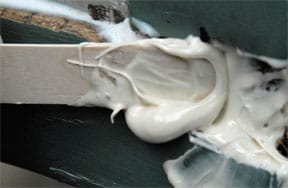
3 Sand, file, and/or rasp the area until it is smooth and flat.
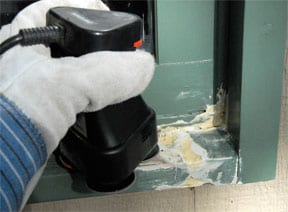
iv Considering the filler lacks pliability, the surface is likely to take dips and voids even later on sanding. Use a putty knife to apply exterior-grade vinyl patching chemical compound to fill whatever remaining holes and voids. Allow this to dry, and and so sand information technology smoothen and repeat if necessary. Finally, prime and pigment within three days.
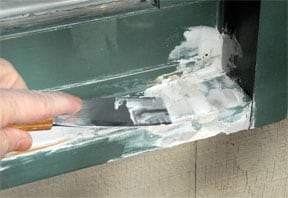
Stuck Double-Hung Window
The most common problem with double-hung windows is that they become stuck in their tracks. This can happen because of high humidity that swells the wood, accumulated crud that blocks the tracks, or repeated painting that seals together the surfaces.
Double-Hung Window Is Temporarily Stuck
If a sash is temporarily stuck because of loftier humidity, but waiting for the weather to change may solve the problem. If a sash moves reluctantly, clean the sash channels.

If the channel is squeezing against the window, widen the channel past inserting a wood cake where it binds and tapping it with a hammer.
If crud is blocking the channel, apply a abrupt woods chisel to remove the blockage. And then, using medium sandpaper wrapped around a wood block, sand the channel. Finally, lubricate the channel with a coating of wax.
If you can't budge the window, use a utility pocketknife to cut the painted edges of the sash. And so work a three-inch-broad putty knife between the sash and frame and tap information technology with a mallet.
From outside, wedge a prybar between the sill and sash; work alternately at each corner so the sash moves up evenly. Protect the sill with a woods block.
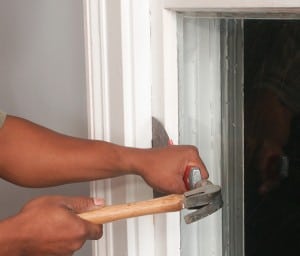
Double-Hung Window Is Painted Shut
If yous accept a double-hung window that has been painted shut, yous can usually go it working again by cut through the pigment that is sealing the sash around its perimeter. Attempt this:
Utilize a utility pocketknife—or, better still, a special trivial tool that looks like a serrated metallic spatula called a window saw (available at pigment and hardware stores for about $ten)—to cut through the paint all around the movable sash. Be careful not to get out whatsoever areas uncut both inside and out and besides take care not to damage the painted surfaces.
Make sure the window is unlocked. Also make sure that in that location are no nails or screws securing the sash to the jamb; if there are, remove them. Then try to force the window open with precipitous forcefulness, using the heels of your easily.
If that doesn't piece of work, try to gratuitous the window with a forest cake and a hammer or mallet, merely be conscientious not to jar the window so hard that you break the drinking glass! Once you lot get the window open, brush away the loose paint.
Window Sash Is Likewise Loose
Although many windows suffer from being besides tight—or worse, completely stuck—some other occasional problem is a window sash that is too loose. All wood shrinks to some degree over time, and forest wears downward from use. The result is a window that rattles in its tracks.
A sash that is likewise loose can be tightened. If the gap is not too wide and the stop is nailed rather than screwed, you tin arrange the stop slightly without actually removing it.
Score the pigment between the stop and the jamb, and place a paper-thin shim between the cease and the sash. Protect the terminate by holding a block of wood confronting information technology, and hammer toward the sash along the length of the end until the paint picture breaks and the cease rests against the shim. Then secure the stop with finishing nails. For broad gaps, reposition the stops.
Some other easy fix is to add an insulation strip to the face of the old parting strip. Information technology may take up simply enough slack in the window, and it likewise adds protection against the elements.
Window Falls Close
Do you have a double-hung window that won't stay open unless you prop it upwardly? Most of the time this is acquired by a cleaved sash cord. This is an inexpensive and relatively piece of cake prepare, just it does take a bit of fourth dimension.
1 Remove the interior stops. To do this, you'll probably have to piece the pigment seal with a utility pocketknife and so, using an one-time chisel, pry off the moldings. If the window has weatherstripping, remove it.
2 Tilt out the lesser sash and remove the sash cords. Lower the weights advisedly (if both sash cords aren't broken). If you lot want to supercede the sash cords in the upper sash, you'll accept to pry out at least one of the departing strips to remove that sash. When you pry the parting strips out, they will more than probable exist ruined, and then plan on buying new ones at a lumberyard.
3 Remove the access panel covers located on the inner face of the window frame.
4 Pass new #7 cotton wool sash cord over each superlative caster and feed it down until information technology drops into the admission area. If necessary, use a bent coat hanger to pull information technology through the access pigsty.
5 At each side, necktie the terminate of the cord onto the sash weight and so, with the weight sitting on the bottom of its channel, pull the cord taut and cutting it off almost 4 inches from the top pulley.
6 Tie a knot and push button the knot into the top slot at the side of the sash. Tack the knot with a brad. Test the action of the window upwardly and downward.
7 Reassemble the residual of the window, reversing the guild of disassembly. Exist sure the stops are non so tight that they crusade the window to bind.
How to Protect a Window Sill
The sill is the role of the frame that takes the worst beating because it extends out from the window. To protect a particularly vulnerable sill, you can cover information technology with a sheet of aluminum and paint it to match the woods. This is actually a very easy project and offers excellent protection.
First, cut a paper template that fits the sill. Lay the template on sail aluminum (available in rolls or sheets at domicile improvement centers), and marking the pattern on the metal. Using can snips, cut out the pattern.
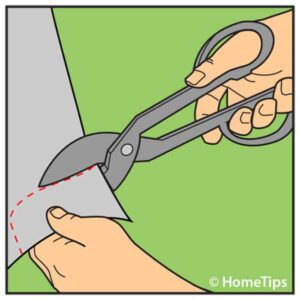
Caulk the sill edges and wedge i side of the aluminum to the stool of the sill and boom it in place with 1-inch roofing nails.
Tape a block of wood over the surface of the aluminum and tap information technology with a hammer and then the aluminum takes on the shape of the sill. Nail it underneath the sill and seal it forth the edges with caulking chemical compound.

Prime with metal primer and pigment to match your trim.
Featured Resources: Observe Local Pre-Screened Window Repair Pros
How To Fix Old Windows That Won't Stay Up,
Source: https://www.hometips.com/repair-fix/windows-double-hung.html
Posted by: macksorece.blogspot.com


0 Response to "How To Fix Old Windows That Won't Stay Up"
Post a Comment